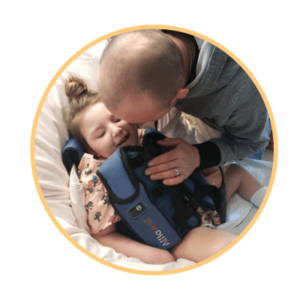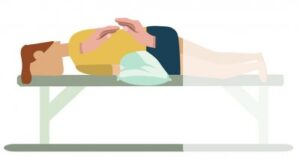The Importance of Respiratory Health in Neurological Disorders
Patients with certain neurological diseases such as Tay-Sachs, Canavan and Sandhoff are at increased risk of developing chest infections, respiratory complications as well as respiratory failure due to respiratory muscular weakness and the inability to clear excess mucus from the airways of the lungs.1 In addition, children and adolescents with progressive neurological disorders have an increased risk of developing pneumonia with any respiratory infection because of their relative lack of mobility. They often have poor cough reflexes and more shallow breathing patterns because of decreased activity levels. Swallowing difficulties also make them more susceptible to aspiration, which can also cause pneumonia.2 Therefore, it is important to identify patients at risk of respiratory complications early in the course of their disease and establish a management plan for respiratory health.
According to the National Tay-Sachs & Allied Diseases Association (NTSAD), the nation’s longest-standing rare disease advocacy organization, promoting respiratory health is an essential aspect of symptom management in neurological disorders such as Tay-Sachs, Canavan and Sandhoff. Affected patients are more susceptible to frequent lung infections due to increased mucus production and reduced swallowing. Developing a respiratory health management plan with primary medical care teams is important and the guidance of a pulmonologist is recommended for more advanced respiratory health needs and management.3

In general, patients with neurologic diseases could have any cough component affected by muscle weakness, bulbar dysfunction, scoliosis, decreased chest wall compliance, or the presence of a tracheostomy, which leads to an ineffective cough. Improper airway clearance, especially with respiratory infections, will lead to mucus plugging that can further cause atelectasis, hypoxemia, pneumonia or respiratory failure. Because of the weakness in expiratory muscles in the lungs, patients often have a decreased cough efficiency and reduced clearance of airway secretions in the lungs, leading to mucus plugging. Cough is crucial for clearance of airway secretions.4

Medical experts will recommend the use of regular airway clearance techniques, which are intended to mobilize mucus in the airways so they can be removed more easily through suction or coughing. An advantage of some airway clearance techniques is that they don’t require the patient’s cooperation and thus can be used on infants, young children, and patients who are not capable of actively participating in the therapy.5
A common airway clearance technique among patients with neurological disorders is chest physical therapy (CPT). CPT consists of a caregiver or physical therapist applying external mechanical maneuvers, such as clapping on the torso, to produce percussion and vibration on the chest in order to enhance mobilization and clearance of mucus. Postural drainage positions such as turning side to side in bed or elevating the foot of the bed can help promote the drainage of secretions while performing CPT.5 However, injury can occur if percussion is done incorrectly, so it is necessary to have a skilled caregiver or trained physical therapist to perform CPT.
A less burdensome, yet effective airway clearance technique is the use of High Frequency Chest Wall Oscillation (HFCWO) therapy vests that apply vibratory forces that oscillate through the chest wall into the lungs to loosen and mobilize secretions. With the use of an HFCWO therapy vest, there is no need for a skilled caregiver and therapy can be easily performed on patients that are immobile or not capable of actively participating in therapy.5 The frequency of airway clearance needs to be customized to each patient and will need to be re-evaluated regularly throughout the patient’s disease course. In general, though, patients will need assistance in clearing their airways daily.
Mobile HFCWO provides another effective airway clearance modality for individuals with neurologic disorders such as Tay-Sachs, Canavan and Sandhoff. AffloVest® was designed with ease-of-use in mind for patients, families and caregivers, to deliver airway clearance therapy that can be managed at home or in the hospital. With no bulky tubes and generators as found in other therapies, the AffloVest can be utilized in any postural position (i.e. laying down, standing, sitting, inclined, reclined etc.) all to help improve the quality of life for patients with neurological, neuromuscular and respiratory diseases.
If desired, a variety of airway clearance therapies may be combined during use with the AffloVest to help optimize airway clearance. With its unique design and the ability to take full, deep breaths during treatment, nebulizer treatments and postural drainage techniques can be combined with AffloVest therapy with the goal of improving lung function and helping improve a person’s quality of life.
Tay-Sachs disease is a rare inherited disorder that progressively destroys nerve cells (neurons) in the brain and spinal cord. Infants with this disorder typically appear normal until the age of 3 to 6 months, when their development slows, and muscles used for movement weaken.6
Canavan disease is a rare inherited disorder that damages the ability of nerve cells (neurons) in the brain to send and receive messages. This disease is one of a group of genetic disorders called leukodystrophies, which disrupt the growth or maintenance of the myelin sheath, which is the covering that protects nerves and promotes the efficient transmission of nerve impulses. These infants usually do not develop motor skills such as turning over, controlling head movement, and sitting without support.7
Sandhoff disease is a rare inherited disorder that progressively destroys nerve cells (neurons) in the brain and spinal cord. Affected infants lose motor skills such as turning over, sitting, and crawling. They also develop an exaggerated startle reaction to loud noises, experience seizures, vision and hearing loss, intellectual disability, and paralysis.8
References:
1. Escobar Henríquez R., Chateau Infante B. (2020) Respiratory Complications in Children with Neurological Diseases. In: Bertrand P., Sánchez I. (eds) Pediatric Respiratory Diseases. 2020 Feb (1): 245-254
2. Yang ML1 Finkel RS. Overview of pediatric neuromuscular disorders and related pulmonary issues: diagnostic and therapeutic considerations. Pediatric Respiratory Diseases. 2010 Mar;11(1):9-17.
3. National Tay-Sachs & Allied Diseases Association (NTSAD) https://www.ntsad.org/
4. Polkey MI, Lyall RA, Moxham J, et al, Respiratory aspects of neurological disease. Journal of Neurology, Neurosurgery & Psychiatry 1999;66:5-15.
5. D. Finder. Airway clearance modalities in neuromuscular disease. Pediatric Respir Rev. 2010 Mar;11(1):31-4
6. Fernandes Filho JA, Shapiro BE. Tay-Sachs disease. Arch Neurol. 2004 Sep;61(9):1466-8.
7. Baslow MH, Guilfoyle DN. Canavan disease, a rare early-onset human spongiform leukodystrophy: insights into its genesis and possible clinical interventions. Biochimie. 2013 Apr;95(4):946-56.
8. Hendriksz CJ, Corry PC, Wraith JE, Besley GT, Cooper A, Ferrie CD. Juvenile Sandhoff disease–nine new cases and a review of the literature. J Inherit Metab Dis. 2004;